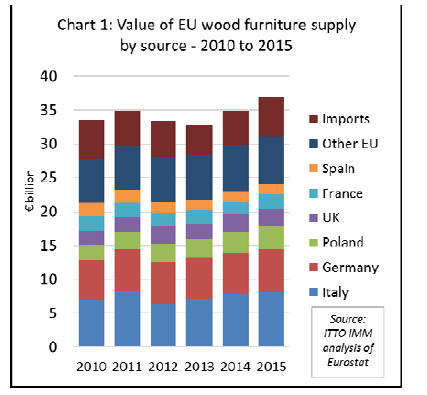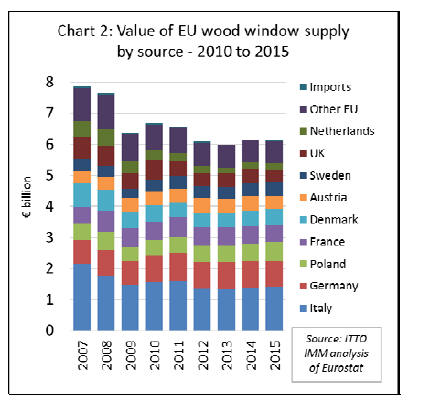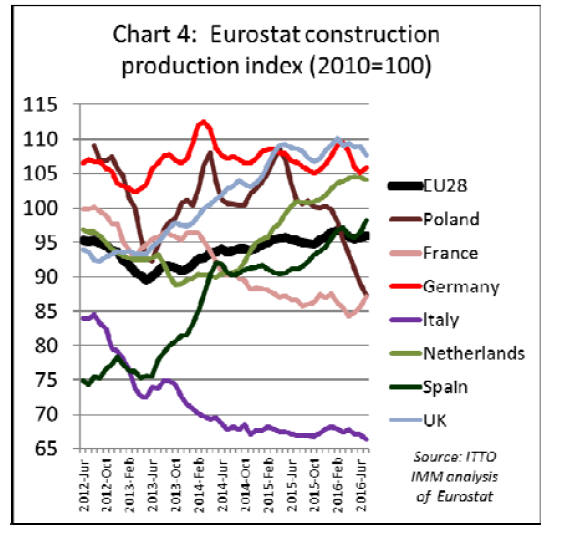|
Report from
Europe
EU recovery still slow and fragile
Eight years on from the financial crises, the recovery in
the EU timber market remains slow and fragile. There is
Europe-wide economic growth and key market sectors
such as construction, furniture, and flooring are
expanding, but the rate of increase rarely exceeds 2% per
year in any individual sector or European country and
some are still flat-lining.
Deflation remains a constant threat despite a Euro 60
billion-a-month programme of quantitative easing
implemented by the European Central Bank – recently
extended at least until March 2017.
Slow growth, low interest rates and quantitative easing has
led to persistent weakness in the value of the euro and
other European currencies on international exchange
markets. Political and economic problems mean that the
Russian rouble and other Eastern European currencies are
even weaker than the Euro.
This, in turn, is undermining demand for imports from
other regions, including the tropics, into the EU and
boosting the relative competitiveness of European
manufacturers.
The UK's decision to exit the EU, taken in a referendum
on 23 June, is another concern, both for the direct effects
on the UK economy and the fallout for wider political and
economic stability in Europe.
Overall the outlook of tropical suppliers of wood products
into the EU is not particularly encouraging.
EU furniture production increases 4.4% in 2015
Eurostat has just published the PRODCOM industrial
production data for 2015 which indicates modest growth
last year in the EU wood furniture sector.
Domestic production of wood furniture (excluding kitchen
furniture) increased 4.4% to Euro31.15 billion in 2015.
Production increased in all the main EU manufacturing
countries including Italy (+4% to Euro8.06 billion),
Germany (+4% to Euro6.35 billion), Poland (+9% to
Euro3.42 billion), the UK (+1% to Euro2.59 billion),
France (+3% to Euro2.05 billion), Spain (+7% to Euro1.53
billion), Sweden (+2% to Euro1.02 billion), Lithuania
(+3% to Euro740 million), Romania (+4% to Euro690
million), and Portugal (+2% to Euro640 million).
Imports of wood furniture from outside the EU were worth
Euro5.73 billion in 2015, 13% more than in 2014, but still
only 16% of furniture supply in the EU. (Chart 1).

Sluggish growth in European window production
The total value of wood windows supplied to the EU
increased only 1.2% to Euro6.11 billion in 2015. There
was rising production in Italy (+2% to Euro1.42 billion),
Poland (+8% to Euro620 million), Denmark (+9% to
Euro550 million) and the Netherlands (+2% to Euro210
million).
Imports of wood windows from outside the EU also
increased by 41% to Euro30 million but still represented a
very small share of overall supply.
These gains were offset by falling production in Germany
(-4% to Euro810 million, France (-5% to Euro530
million), Austria (-9% to Euro410 million) and the UK (-
13% to Euro410 million). Wood window production in
Sweden remained stable at Euro440 million in 2015.
(Chart 2).

More robust growth in the EU wood door sector
Growth in the EU wood door sector was more robust than
in the window sector in 2015. The total value of wood
doors supplied to the EU increased 7% to Euro6.62 billion
in 2015. There was rising production in Germany (+6% to
Euro1.21 billion), UK (+7% to Euro930 million), Poland
(+11% to Euro440 million), Spain (+19% to Euro420
million) and the Netherlands (+5% to Euro180 million).
Imports of wood doors from outside the EU increased by
17% to Euro33 million. These gains were offset by falling
production in France (-2% to Euro690 million, Sweden (-
1% to Euro260 million), and Austria (-3% to Euro250
million). Wood door production in Italy remained stable
at Euro800 million in 2015. (Chart 3).

EU construction dips again in 2016
Rising furniture and joinery production in the EU during
2015 mirrors the slow recovery in construction activity
during the year.
The Eurostat Construction Production Index for EU
member states shows that construction activity rose
sharply at the end of last year, with notable upturns in
Germany, the UK, Spain, the Netherlands and France.
However, activity across the EU dipped again this year.
Activity in Poland has slowed very dramatically during
2016. The total value of EU construction in July 2016 was
still 5% lower than in 2010 and 20% down on 2008. The
Italian market remains particularly weak (Chart 4).

FLEGT licenses fine, but success in the market
depends on quality, shipment and price
Earlier this month, ITTO reported that Indonesia is due to
issue the first FLEGT licenses in November and observed
that the Indonesian government and industry are looking
to these licenses to deliver significant market advantages
(ITTO TTM Report 1–15 September 2016).
There are reasons for optimism, FLEGT Licensing gives a
green lane through the EUTR due diligence procedures,
the economic advantages of developing a single unified
system for all exporters, and the greater confidence such a
system offers to both buyers and investors.
These are all benefits which will give Indonesian wood
products a competitive edge in the EU market in the
months ahead. However, prospects for Indonesian timber,
and indeed any timber supplier into the EU market, are not
only dependent on their ability to provide legality licenses.
The first question for international buyers, both in the EU
and elsewhere, is not whether or not they have a FLEGT
license or other assurance of legality or sustainability, but
rather are they able to offer products which are good
quality, on time and at a reasonable price.
Various indices of international competitiveness suggest
that Indonesian exporters face significant challenges on
these wider market issues. For example, in 2015, the
World Bank ranked Indonesia at 109th on the “Ease of
Doing Business” (EDB), significantly lower than
Indonesia’s direct competitors in the timber sector such as
Malaysia (18th), Thailand (49th), China (84th) and
Vietnam (90th).
The UNCTAD Line Shipping Connectivity Index shows
that the logistics of shipping to world markets are
significantly more challenging in Indonesia than in other
South East Asian countries.
In practice these indices imply that Indonesian products
tend to be more expensive and to be subject to longer
delivery times than competing products from elsewhere.
At a High Level Market Dialogue held in Jakarta in
November 2015, the Chairman of the Indonesian Furniture
and Craft Association AMKRI commented that some
furniture manufacturers are moving away from Indonesia
to Vietnam because of ‘red tape’ and cost. Prices for
equivalent furniture manufactured in Indonesia may be
15% to 20% higher than in Vietnam.
The wider macro-economic background in Europe also
presents challenges to Indonesian wood products.
Indonesian exporters have to contend with the relative
weakness of the euro, slow pace of recovery from the
financial crises, the dominant position of domestic and
Chinese manufacturers, and the strong fashion for
temperate woods and wider market prejudices against
tropical timbers.
But it would be wrong to over emphasise the downside.
Growth in the EU may be slow, but it is significant given
the sheer size and wealth of the European economy.
Despite barriers to Indonesia’s competitiveness in the EU,
Indonesia is now the largest single supplier of tropical
timber products into the EU by a significant margin.
In the 12 months to end June 2016, the EU imported
Euro1.01 billion of timber products from Indonesia,
including Euro490 million of wood products (HS 44),
Euro310 million of wood furniture (HS 94) and Euro213
million of paper (HS 48).
This compares to Euro799 million from Vietnam (second
largest supplier - nearly all furniture) and Euro533 million
from Malaysia. Indonesia accounted for nearly a quarter of
all EU timber product imports from tropical countries in
the twelve month period.
Indonesia’s competitive position in various sectors
In practice the competitive position of Indonesian timber
products in the EU varies widely between sectors. In some
sectors for niche tropical wood products, Indonesia is
already the leading supplier and FLEGT licenses will
provide an opportunity to extend this lead.
Indonesia is the largest external supplier of “continuously
shaped” wood (HS code 4409) which includes both
decking products and interior decorative products like
moulded skirting and beading.
EU imports of this commodity from Indonesia increased
3% from 88 000 cu.m in 2014 to 91000 cu.m in 2015 and
Indonesia’s share of total imports (tropical and temperate)
in both years was around 26%.
Indonesia is also the largest tropical supplier of wood
flooring to the EU. Although still low by historical
standards, EU imports from Indonesia increased 4% to
1.59 million sq.m in 2015.
This is only a very small share of the overall EU market,
which consumes over 100 million sq.m of wood flooring
every year and which imported 29 million sq.m in 2015.
However, the FLEGT license should help rebuild the niche
market for tropical wood floors, which still offer strong
benefits - including a unique look and good durability –
but have gone out of fashion in the EU in recent years.
It’s notable that China, by far the EU’s largest single
external supplier of wood floors, suffered a set-back in the
EU market last year, with EU imports of Chinese wood
flooring falling 7.4% to 17.5 million sq.m, the lowest level
since 2005.
Whether this might signal new opportunities for
competing external suppliers like Indonesia, or is a sign of
consumers turning more to domestic products, is hard to
say at this stage.
Plywood is a market sector where FLEGT licenses might
play an important role to boost demand for Indonesian
product. EU imports of plywood from all sources
increased sharply between 2013 and 2015, from 3.38
million cu.m to 3.92 million cu.m, a level not seen since
before the financial crises.
However, imports from Indonesia and other tropical
countries have remained stubbornly low in recent years.
After increasing 3% to 308,000 cu.m in 2014, EU imports
of plywood from tropical countries fell back 6% to
291,000 cu. m in 2015.
The share of tropical countries in EU plywood imports fell
from 9.2% in 2013 to only 7.8% in 2015, the lowest level
for at least the last 20 years, and probably much longer.
Imports from Indonesia fell 5% from 117,000 m3 in 2014
to 112,000 m3 in 2015.
However, Indonesia became the largest single tropical
supplier of plywood to the EU last year as imports from
Malaysia fell 11% from 121,000 m3 in 2014 to 107,000
m3 in 2015.
In recent years, tropical hardwood faced plywood has lost
share in the EU mainly to Chinese plywood faced with
temperate hardwood (including poplar, eucalyptus and
birch), and to Russian birch plywood.
The plywood sector has been a strong focus for EUTR
enforcement activities to date and, given difficulties of
establishing traceability and relatively high illegality risk
of some competing suppliers, Indonesia FLEGT license
should significantly boost competitiveness in this sector.
Uphill struggle to increase share of EU furniture
market
Indonesia faces more of an uphill struggle to increase
market share in the furniture sector. This is particularly
critical given the sheer size of the market and the potential
it offers to add value to the wood resource.
However, it’s also a sector where the technical advantages
of tropical wood are less relevant – at least in the interior
furniture market which dominates sales – than wider
competitiveness issues such as labour costs, red tape,
logistics, processing efficiency, innovation, and marketing.
Indonesia faces considerable competition in this sector,
not least from the EU’s domestic furniture manufacturers
which are hugely dominant, accounting for 84% of all
furniture supplied within the EU in 2015.
One clear sign of the rising global competitiveness of
EU’s domestic manufacturers, boosted by the weak euro,
is the region’s rising trade surplus in wood furniture.
While EU countries imported wood furniture worth
Euro5.78 billion from outside the EU in 2015, EU exports
of wood furniture rose to Euro8.73 billion in 2015, up only
3.5% from 2014 but 51% more than in 2009.
EU imports of Indonesian wood furniture increased by 7%
to Euro316 million in 2015, which is encouraging but less
dramatic than from other countries. EU imports of wood
furniture from Vietnam increased 21.6% to Euro725
million in 2015. This follows 19% growth the previous
year and is a clear demonstration of Vietnam’s rising
competitiveness in global furniture manufacturing.
Despite Vietnam’s rise, more than half of all EU wood
furniture imports, Euro3.15 billion, came from China in
2015, with deliveries rising 12%.
In 2015, EU imports also increased rapidly from Malaysia
(+12% to Euro191 million), Turkey (+21% to Euro183
million) and India (+23% to Euro162 million).
Mixed prospects for FLEGT licensed timber products
In short, there are reasons to believe that FLEGT licensing
will help improve competitiveness and could provide a
fairly immediate boost to trade in those sectors where
Indonesia has already established a strong market position
and where EUTR regulatory activity has been focused –
such as decking, plywood and wood flooring.
However, significant gains in market share over the long
term, particularly in high value sectors like furniture, will
only be achieved if FLEGT licensing is combined with
policies to improve the international competitiveness of
Indonesian wood manufacturers across a wider range of
issues.
The good news is that the FLEGT process has some
potential to enhance this process through the role it plays
to increase industry co-operation, improve dialogue and
information exchange with customers and suppliers, raise
the overall image of Indonesian products and potentially
encourage investment by reducing actual and perceived
business risk.
Indonesian supply of wood products to the EU must also
be set within the context of the wider market opportunities
available to Indonesian manufacturers. The influential
“Global Construction 2030” report by Oxford Economics
published in 2015 forecast that Indonesia will rise to
become the world’s fourth largest construction market by
2030.
The value of Indonesian construction is predicted to rise
from around US$250 billion in 2015 to nearly US$700
billion in only 15 years, moving up from its current
position as the 11th largest market to overtake Japan.
The same report suggests that European construction will
also grow, but only slowly from around US$1,800 billion
in 2015 to US$2,250 billion in 2030, little more than the
total value of the European market in 2007 before the
crash (US$2200 billion).
Therefore, the key challenge, and opportunity, for the
SVLK system on which FLEGT licensing is based may
ultimately lie in the role it plays to promote efficient
delivery of legal and sustainable timber products into the
domestic market and to promote new investment in forest,
technical and human resources to supply that market.
|